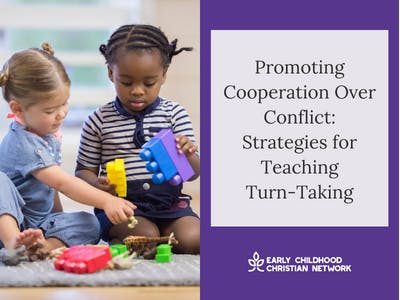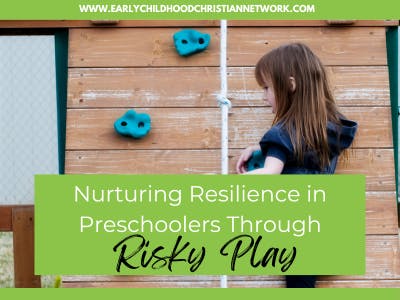|
Hey Reader!
In a national parent survey conducted by zerotothree.org, 43% of parents that were surveyed thought children should be good at sharing by around age 2. In reality, the skills of sharing and taking turns begin developing around ages 3-6 when children begin to assert power over their environments (you can read about Erikson’s Theory HERE). This is the time where they really begin to start making friends and playing cooperatively rather than just next to each other (parallel play). Keep that in mind as we talk about taking turns and sharing today!
Most of us use phrases like “we have to share the toys” regularly in our classrooms and in our homes. I might challenge you a little bit today so I hope you’ll keep reading till the end!
- Sharing and taking turns are actually 2 different things. When I share a cookie with you, I get a piece and you get a piece. Typically, I can’t share a toy truck with you. Either I have it or you have it so we’re really taking turns rather than sharing it. It’s pretty hard to both play with it at the same time. Now, if I have 3 trucks, I could share a truck with you. It seems like I’m splitting hairs right? Stay with me…
- Children younger than 3 typically aren’t ready to take turns or share in any meaningful way but you can start practicing the skills and using the vocabulary with them. It doesn’t mean we let toddlers and two year olds act mean to each other – just keep in mind that you are teaching them how to be a friend and being selfish at this age is totally normal.
- Forcing children to share and/take turns is actually detrimental to both children – the one who “had it first” and the one who “wants it now”. Hear me out.
For the one who “had it first”
When you force this child to give up an item before they are done with it, here is what they learn:
- My “work” (play) is not important
- I have to give up something that I like
- Sharing and taking turns makes me feel sad and mad
- I definitely don’t want to do this again.
|
|
For the one who “wants it now”
Here is what this child learns:
- When I grab something, I get what I want
- What I want is more important than anyone else
- I don’t have to wait for anything that I want
- I need an adult to help me solve problems
|
I’d like to encourage you start focusing on “taking turns”. When you take turns, you can finish what you’re doing and THEN hand it over to the other child. What do children learn when they are allowed to (and taught how to) take turns?
For the child who “had it first”:
- I can stand up for myself and set boundaries.
- I can finish my work in peace and continue learning and exploring until I’m done.
- I can freely take turns because I know I’ll also get a long turn if I need it.
- It feels good to hand this off to the next person. I think I might do this again.
|
|
For the child who “wants it now”:
- I can learn to ask for what I want rather than just grabbing.
- I don’t always get what I want right way and I can survive disappointment.
- Waiting is really hard but I can do it.
- When it’s my turn, I know I’ll have as long as I need.
- I’m showing self-control!
|
Tips for teaching 3s and 4s how to take turns in a fun way!
Remember, teaching these skills in a FUN way actually reinforces the positive neural connections in their brains for taking turns! Then when it’s time to practice during play-time, their little brains are already wired to wait and they’re wired to let go.
- Play group games like ‘hot potato’. Start out playing in a small group with just 3 or 4 children so their “turn” comes around often! This helps children learn to let go of items freely. As they start “getting it”, add more children the next time. Pretty soon, you’ll be able to play in a large group gathering with all of your students.
- Use novelty items like puppets or stuffed animals to talk to children about their (imaginary) experiences with resolving conflict with their peers when they wanted a turn (or needed to end their turn). Allow children to role play this out themselves in a dramatic play or puppet center.
- Use a “talking stick” in your large group time where only the child with the “talking stick” can speak. Allow them to speak until they’re done no matter how long it takes. (You might want to start this with a smaller group as well so children don’t have to wait too long the first few times they’re practicing.) Use phrases like “Sometimes it’s hard to wait, but when it’s your turn, you’ll have as much time as you need, too.”
- Play relay games where children have to hand off a “baton” of some kind before the next person can go. They learn how to let go of a physical item in order to start someone else’s turn. Make sure the children don’t have to wait too long. They shouldn’t be waiting for more than 3 or 4 other children to go before they take a turn.
What about toddlers and twos?
In these younger classrooms, it’s really important to have lots of trucks and trains and blocks and everything else children are playing with. Toddlers and twos teachers should not be spending a large part of the day “making” children take turns.
- Begin using phrases like “Evelyn is done with the blue marker so she is ready for someone else to have a turn.” or “Jacob, you have two trucks and it looks like Sam would like to play too. Which truck would you like to give him?” In this case, you’re not forcing Jacob to share those trucks. If he says no, then offer Sam a third truck that is not interesting to Jacob right now. This is not reinforcing selfishness (which is totally appropriate at this age, by the way), but rather allowing Jacob to practice making decisions on his own and helping Sam handle disappointment and problem-solve. As Jacob matures (ages 3-6), we’ll work on what it looks like to take other’s feelings into consideration.
- You can also play games like rolling a ball back and forth between you and a child or two or using puppets to role play taking turns. Even using phrases like “It’s my turn to talk and your turn to listen.” and “Now it’s my turn to listen and your turn to talk” reinforce the behavior that we want to see!
- “Notice” children who are sharing or taking turns out loud. “Evelyn, I see you gave that block to Sarah so she could have a turn. That’s very kind.” “Jacob, you gave Sam the book after you were done. You’re giving him a turn.”
Whew! This was a long one. If I stepped on your toes a little bit, please forgive me. I hope you’ve at least given some thought to whether your expectations are age-appropriate and also whether your focus is on what you want children TO do rather than what you want then NOT to do. As always, I love to hear your feedback and I hope you’ll check out our social media this week where we’ll offer a few more tips and tricks for helping little ones learn how to take turns and share.
Cheering you on this week!
-Your ECCN team
P.S. Question for you: What’s the biggest challenge you’re facing in your classroom right now? We’d love to hear from you!
Colossians 3:16
“Let the message of Christ dwell among you richly as you teach and admonish one another with all wisdom through psalms, hymns, and songs from the Spirit, singing to God with gratitude in your hearts.”
|






